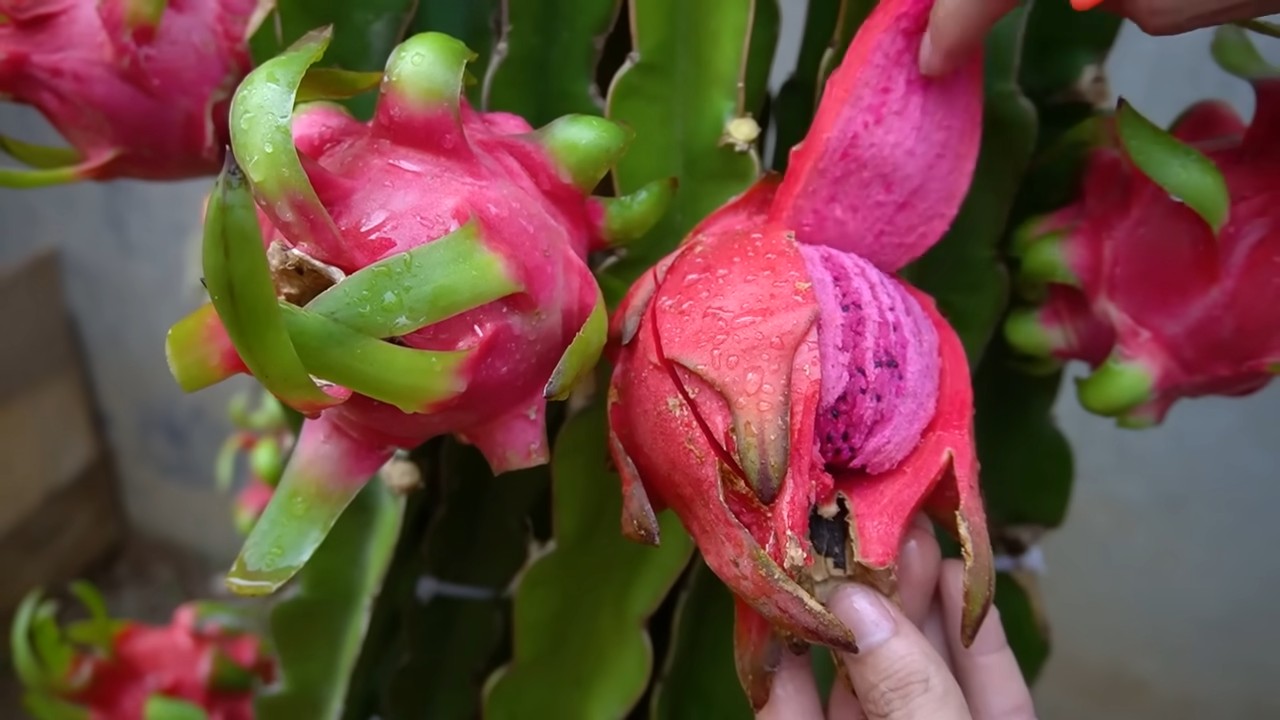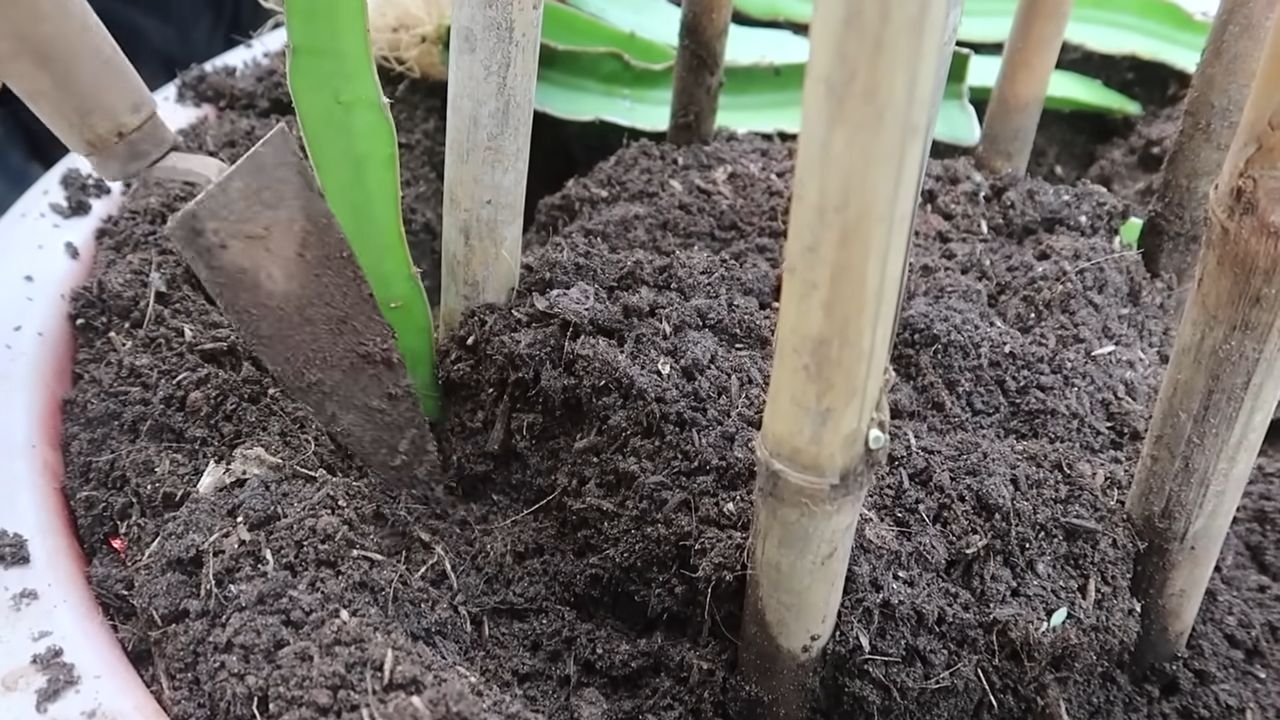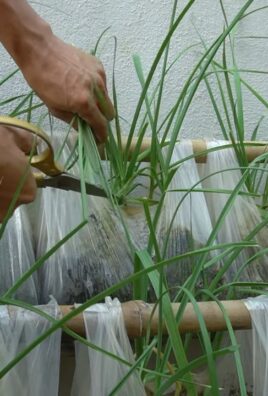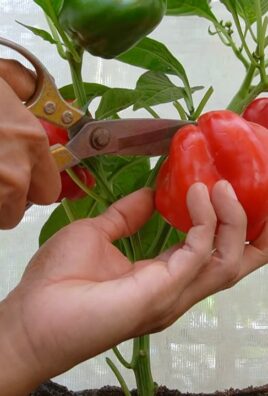Grow Red Dragon Fruit, and transform your backyard into a tropical paradise! Imagine harvesting your own vibrant, exotic fruit right from your garden. Forget those expensive grocery store prices and bland imports – with a little know-how, you can cultivate these beauties yourself.
The Red Dragon Fruit, also known as pitaya, isn’t just a pretty face. Originating in Central America, it has a rich history, with ancient cultures valuing it for both its delicious flavor and potential health benefits. Today, it’s enjoyed worldwide, but often at a premium. That’s where our DIY guide comes in!
Why should you embark on this gardening adventure? Well, beyond the sheer satisfaction of growing your own food, learning how to grow Red Dragon Fruit offers a sustainable and rewarding experience. Many people are intimidated by the idea of growing exotic fruits, thinking it’s too difficult or requires specialized equipment. But I’m here to tell you it’s totally achievable with the right techniques and a little patience. This article will break down the process into easy-to-follow steps, revealing simple DIY tricks and hacks that will have you harvesting your own dragon fruit in no time. We’ll cover everything from choosing the right variety and preparing the soil to providing the necessary support and protecting your plants from pests. Get ready to impress your friends and family with your newfound gardening skills and enjoy the sweet, refreshing taste of homegrown Red Dragon Fruit!

Growing Red Dragon Fruit at Home: A DIY Guide
Hey there, fellow plant enthusiasts! Ever dreamt of having your own exotic fruit garden? Well, let me tell you, growing red dragon fruit (Hylocereus undatus) at home is totally achievable, and it’s a rewarding experience. I’ve been growing these beauties for a few years now, and I’m excited to share my knowledge with you. It might seem daunting at first, but trust me, with a little patience and the right guidance, you’ll be enjoying your own homegrown dragon fruit in no time!
What You’ll Need: The Essentials
Before we dive into the nitty-gritty, let’s gather our supplies. Here’s a checklist of what you’ll need to successfully grow red dragon fruit:
* Dragon Fruit Cutting or Seedling: You can either start from a cutting (which is faster) or from seeds (which takes longer but is a fun experiment). I recommend starting with a cutting from a reputable source.
* Well-Draining Soil: Dragon fruit hates soggy roots! A mix of cactus potting mix, perlite, and a bit of compost works wonders.
* Large Pot (if growing in a container): Choose a pot that’s at least 24 inches in diameter and depth. Remember, these plants can get big!
* Support Structure: Dragon fruit is a climbing cactus, so it needs something to climb on. A sturdy trellis, a post, or even a strong tomato cage will do the trick.
* Gardening Gloves: Protect your hands from the spines!
* Pruning Shears: For trimming and shaping your dragon fruit plant.
* Slow-Release Fertilizer: A balanced fertilizer formulated for cacti or succulents.
* Watering Can or Hose: For watering your plant.
* Sunlight: Dragon fruit loves sunshine!
Getting Started: Propagation and Planting
Okay, let’s get our hands dirty! This section covers how to start your dragon fruit journey, whether you’re using a cutting or seeds.
Starting from a Cutting: The Quick Route
This is my preferred method because it’s faster and more reliable.
1. Prepare the Cutting: If you bought a cutting, let it callous over for about a week in a dry, shaded area. This helps prevent rot when you plant it. If you took a cutting yourself, make sure it’s at least 12 inches long.
2. Prepare the Pot: Fill your pot with the well-draining soil mix, leaving a few inches of space at the top.
3. Plant the Cutting: Insert the calloused end of the cutting about 2-3 inches into the soil.
4. Water Lightly: Water the soil gently, just enough to moisten it. Avoid overwatering!
5. Provide Support: Place the support structure in the pot near the cutting. You can gently tie the cutting to the support to encourage it to climb.
6. Find a Sunny Spot: Place the pot in a location that receives at least 6-8 hours of sunlight per day.
7. Be Patient: It can take a few weeks for the cutting to root. Keep the soil slightly moist but not soggy. You’ll know it’s rooting when you see new growth.
Starting from Seeds: The Patient Path
This method takes longer, but it’s a fun experiment if you’re up for the challenge.
1. Extract the Seeds: Cut open a ripe dragon fruit and scoop out the pulp.
2. Clean the Seeds: Place the pulp in a bowl of water and gently rub it to separate the seeds from the pulp. Rinse the seeds thoroughly.
3. Dry the Seeds: Spread the seeds on a paper towel and let them dry completely for a few days.
4. Prepare a Seed Starting Tray: Fill a seed starting tray with a seed starting mix.
5. Sow the Seeds: Sprinkle the seeds evenly over the surface of the soil.
6. Cover Lightly: Cover the seeds with a very thin layer of soil.
7. Water Gently: Mist the soil with water to moisten it.
8. Create a Humid Environment: Cover the tray with a plastic dome or plastic wrap to create a humid environment.
9. Place in a Warm Location: Place the tray in a warm location that receives indirect sunlight.
10. Be Patient: It can take a few weeks for the seeds to germinate. Keep the soil moist but not soggy.
11. Transplant Seedlings: Once the seedlings are large enough to handle (a few inches tall), transplant them into individual pots filled with well-draining soil. Follow steps 2-7 from the “Starting from a Cutting” section to plant them in their permanent pots with support.
Caring for Your Dragon Fruit Plant: The Nurturing Phase
Now that your dragon fruit plant is planted, it’s time to provide it with the care it needs to thrive.
1. Watering: Dragon fruit prefers to be watered thoroughly when the soil is dry to the touch. Avoid overwatering, as this can lead to root rot. During the growing season (spring and summer), you may need to water more frequently. In the winter, reduce watering. I usually stick my finger about an inch into the soil to check for moisture before watering.
2. Fertilizing: Feed your dragon fruit plant with a balanced slow-release fertilizer formulated for cacti or succulents. Apply the fertilizer according to the package instructions. Fertilize during the growing season (spring and summer) every 2-3 months.
3. Sunlight: Dragon fruit needs plenty of sunlight to thrive. Aim for at least 6-8 hours of direct sunlight per day. If you’re growing your plant indoors, place it near a sunny window or use a grow light.
4. Pruning: Pruning is essential for shaping your dragon fruit plant and encouraging fruit production. Prune away any dead or damaged branches. You can also prune to control the size and shape of the plant. The best time to prune is after the plant has finished fruiting. I usually prune mine in late winter or early spring.
5. Support: Make sure your dragon fruit plant has adequate support to climb on. As the plant grows, gently tie the branches to the support structure.
6. Pest and Disease Control: Dragon fruit is relatively pest-resistant, but it can be susceptible to mealybugs and scale. Inspect your plant regularly for pests and treat them promptly with insecticidal soap or neem oil. Root rot can be a problem if the soil is not well-draining or if the plant is overwatered.
7. Pollination: Dragon fruit flowers are nocturnal and are typically pollinated by bats or moths. If you’re growing your plant indoors or in an area where these pollinators are not present, you may need to hand-pollinate the flowers. Use a small paintbrush to transfer pollen from the stamen (male part) to the pistil (female part) of the flower. I usually do this in the evening when the flowers are fully open.
Encouraging Fruit Production: The Sweet Reward
Getting your dragon fruit plant to produce fruit is the ultimate goal! Here are some tips to help you achieve a bountiful harvest:
1. Maturity: Dragon fruit plants typically start producing fruit after 1-2 years.
2. Sunlight: Ensure your plant receives plenty of sunlight, as this is crucial for fruit production.
3. Watering: Water regularly during the growing season, but avoid overwatering.
4. Fertilizing: Fertilize with a fertilizer that is high in phosphorus and potassium to promote flowering and fruit development.
5. Pollination: Hand-pollinate the flowers if necessary.
6. Patience: Be patient! It can take some time for the plant to mature and start producing fruit.
Harvesting Your Dragon Fruit: The Moment of Truth
Harvesting your own dragon fruit is an incredibly satisfying experience. Here’s how to know when your fruit is ready to pick:
1. Color Change: The skin of the fruit will change from green to bright red or pink, depending on the variety.
2. Slight Softness: The fruit should be slightly soft to the touch, like a ripe avocado.
3. Easy Detachment: The fruit should detach easily from the stem when gently twisted.
4. Enjoy! Once harvested, you can enjoy your delicious homegrown dragon fruit!
Troubleshooting: Common Issues and Solutions
Even with the best care, you might encounter some challenges along the way. Here are some common issues and how to address them:
* Yellowing Leaves: This could be a sign of overwatering, underwatering, or nutrient deficiency. Adjust your watering schedule and fertilize as needed.
* Root Rot: This is caused by overwatering and poor drainage

Conclusion
So, there you have it! Growing your own Red Dragon Fruit from seed might seem like a tropical dream, but with a little patience and the right guidance, it’s an achievable reality. We’ve walked you through the entire process, from seed extraction and germination to transplanting and ongoing care. Why is this DIY trick a must-try? Because it offers a unique connection to your food, a rewarding gardening experience, and the potential to harvest your own delicious and vibrant Red Dragon Fruit right in your backyard. Imagine the satisfaction of biting into a fruit you nurtured from a tiny seed!
Beyond the sheer joy of gardening, growing Red Dragon Fruit offers several practical benefits. You’ll have access to fresh, organic fruit free from pesticides and herbicides. You’ll also save money compared to purchasing it at the store, especially considering the often-premium price tag of this exotic fruit. Plus, the Red Dragon Fruit plant itself is a stunning addition to any garden, with its unique climbing structure and beautiful, fragrant flowers that bloom at night.
Don’t be afraid to experiment with variations! Consider different potting mixes to find what works best for your local climate and soil conditions. You can also try growing your Red Dragon Fruit in containers, which allows you to move the plant indoors during colder months if you live in a region with harsh winters. Another exciting variation is to graft different varieties of Red Dragon Fruit onto a single plant, allowing you to enjoy a wider range of flavors and colors. You could even try training your dragon fruit to grow along a fence or trellis for a visually stunning display.
We understand that growing Red Dragon Fruit from seed can seem daunting at first, but we encourage you to take the plunge. The journey is just as rewarding as the destination. The key is to be patient, observant, and willing to learn along the way. Don’t be discouraged by setbacks; even experienced gardeners encounter challenges. The important thing is to keep learning and adapting your approach.
We are confident that with the information provided in this guide, you’ll be well-equipped to successfully grow your own Red Dragon Fruit. So, grab your seeds, prepare your potting mix, and get ready to embark on this exciting gardening adventure!
Now, we want to hear from you! Have you tried growing Red Dragon Fruit from seed before? What were your experiences? What challenges did you face, and how did you overcome them? Share your tips, tricks, and photos in the comments below. Let’s create a community of Red Dragon Fruit enthusiasts and learn from each other’s successes and failures. Your insights could be invaluable to other aspiring gardeners.
We believe that everyone can experience the joy of growing their own food, and Red Dragon Fruit is a fantastic place to start. So, go ahead, give it a try, and let us know how it goes! Happy gardening!
Frequently Asked Questions (FAQ)
What is the best time of year to plant Red Dragon Fruit seeds?
The ideal time to plant Red Dragon Fruit seeds is during the spring or early summer. This allows the seedlings to benefit from the warmer temperatures and longer daylight hours, which are crucial for their growth and development. In warmer climates, you can technically start them indoors any time of year, but providing supplemental light during the shorter days of winter is essential. Starting in spring gives them the best natural advantage.
How long does it take for Red Dragon Fruit seeds to germinate?
Germination time can vary, but generally, Red Dragon Fruit seeds will germinate within 1 to 3 weeks. Factors such as temperature, humidity, and the freshness of the seeds can influence the germination rate. Maintaining a consistently warm and humid environment is key to successful germination. Using a heat mat can help speed up the process, especially in cooler climates.
What type of soil is best for growing Red Dragon Fruit?
Red Dragon Fruit thrives in well-draining soil that is rich in organic matter. A mix of cactus potting mix, perlite, and compost is often recommended. The soil should be slightly acidic to neutral, with a pH between 6.0 and 7.0. Good drainage is crucial to prevent root rot, which is a common problem for Red Dragon Fruit plants. Avoid heavy clay soils that retain too much moisture.
How often should I water my Red Dragon Fruit plant?
Watering frequency depends on the climate and the stage of growth of the plant. Generally, water deeply when the top inch of soil feels dry to the touch. Avoid overwatering, as this can lead to root rot. During the growing season (spring and summer), you may need to water more frequently than during the dormant season (fall and winter). Always check the soil moisture before watering.
How much sunlight does Red Dragon Fruit need?
Red Dragon Fruit requires at least 6-8 hours of direct sunlight per day to thrive. However, young seedlings can be sensitive to intense sunlight, so it’s best to provide them with some shade during the hottest part of the day. As the plant matures, it can tolerate more direct sunlight. If growing indoors, supplement with grow lights to ensure adequate light exposure.
What kind of support structure does Red Dragon Fruit need?
Red Dragon Fruit is a climbing cactus, so it needs a strong support structure to grow properly. A trellis, fence, or sturdy post with a circular support at the top are all good options. The plant will use its aerial roots to cling to the support structure. Ensure the support is strong enough to handle the weight of the mature plant, which can become quite heavy.
How long does it take for a Red Dragon Fruit plant to produce fruit?
It typically takes 1 to 3 years for a Red Dragon Fruit plant grown from seed to produce fruit. Grafted plants, on the other hand, can produce fruit much sooner, often within a year. Factors such as climate, soil conditions, and proper care can influence the time it takes for the plant to fruit. Patience is key!
What are some common pests and diseases that affect Red Dragon Fruit?
Common pests that can affect Red Dragon Fruit include aphids, mealybugs, and spider mites. These pests can be controlled with insecticidal soap or neem oil. Root rot is a common disease that can occur due to overwatering or poor drainage. To prevent root rot, ensure the soil is well-draining and avoid overwatering. Fungal diseases can also affect the plant, so it’s important to maintain good air circulation and avoid overhead watering.
Can I grow Red Dragon Fruit in a container?
Yes, Red Dragon Fruit can be successfully grown in containers, especially if you live in a region with cold winters. Choose a large container with good drainage holes. Use a well-draining potting mix and provide a sturdy support structure for the plant to climb on. Container-grown plants may require more frequent watering and fertilization than those grown in the ground.
How do I pollinate Red Dragon Fruit flowers?
Red Dragon Fruit flowers are nocturnal and typically open at night. While some varieties are self-pollinating, others require cross-pollination to produce fruit. If you’re not sure if your variety is self-pollinating, it’s best to hand-pollinate the flowers. Use a small brush to transfer pollen from the stamen (male part) of one flower to the pistil (female part) of another flower. Hand-pollination is most effective in the early morning hours after the flowers have opened.
How do I know when my Red Dragon Fruit is ripe?
A ripe Red Dragon Fruit will have a vibrant, even color and will be slightly soft to the touch. The “wings” or scales on the fruit will start to dry out and may turn brown. The fruit should also have a slight give when gently squeezed. Avoid picking the fruit too early, as it will not ripen further off the vine.
What are some variations I can try when growing Red Dragon Fruit?
Experiment with different varieties of Red Dragon Fruit to find your favorite flavors and colors. Try grafting different varieties onto a single plant to enjoy a wider range of fruit. You can also experiment with different potting mixes and fertilization methods to optimize growth and fruit production. Consider training your dragon fruit to grow along a fence or trellis for a visually stunning display.




Leave a Comment